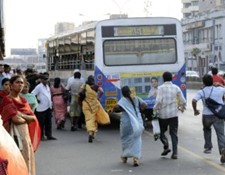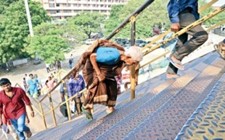It is indeed surprising, that despite being a culture that supposedly reveres the elderly, we don’t give the needs of the aged and the disabled in India any thought at all.
To truly appreciate how insensitive we are to the needs of the elderly (and the disabled), do this mental exercise. Imagine yourself to be wheelchair bound. Actually, let us not go that far yet. Just imagine you are an old person with slightly diminished reflexes and minor balance issues that necessitate you to carry a walking stick for balance. With that firmly in mind, now take a look at the world around you.
 One of the few roads in Chennai with a footpath. Notice how there is construction debris all over the pavement and the two ladies are being forced to walk on the road, risking the prospect of being run over.
One of the few roads in Chennai with a footpath. Notice how there is construction debris all over the pavement and the two ladies are being forced to walk on the road, risking the prospect of being run over.
We have all experienced the serious challenges involved in walking on Indian roads. Now imagine you are that old person. Now think of walking on roads which lack pavements and have heavy and unregulated traffic driven by reckless and insensitive drivers. While you are looking both ways and dodging traffic, don’t forget to bend down and avoid all the wires and cables, thoughtlessly strung from poles, trees and buildings. Finally, remember to jump over the pits and trenches left open by various civic bodies. All this when you are weak and feeble!
The dangers of walking around on Indian streets today prevent countless elders and disabled from leaving the relative safety of their homes. Many of them forego their usual walks, their trips to places of worship, or even to banks and post offices to collect their pensions because of their fear of being run over or getting seriously injured.
Now take a look at the public transport available in your city.
 The picture on the right shows the true story. Look at how everyone is running to get into the bus. Notice the slower ones struggling to reach the bus. Imagine now that you are an old person incapable of running!
The picture on the right shows the true story. Look at how everyone is running to get into the bus. Notice the slower ones struggling to reach the bus. Imagine now that you are an old person incapable of running!
Buses come swerving in at breakneck speed and stop somewhere in the vicinity of the bus stop, wait but for a few seconds and speed away before everyone has safely boarded. With steep steps that only the young can jump onto, riding buses in India is meant only for the young and agile.
Trains are no better. Suburban trains, especially, are a challenge even for the young and nimble unless they are used to them. If you go to Mumbai for example, unless you are a regular traveller, there is very little chance of making it on to any of the suburban trains during peak hours. And if you do manage to get on, you may not be able to get off till the train reaches its last station! Long distance trains, though not as crowded, present us with other challenges. Their steps are practically upright ladders that have to be negotiated to get into them. If one is wheelchair bound, it is impossible to get on to the train at all, leave alone reach one’s seat, given how narrow the doors and passages are.
 This picture with the bent over old lady is a picture of the foot over bridge at the Chennai Central Railway station. The picture says it all.
This picture with the bent over old lady is a picture of the foot over bridge at the Chennai Central Railway station. The picture says it all.
Next let us look at the insides public places and buildings. Many banks, post offices and insurance buildings are in old buildings with no elevators. Most of their offices are on the first or second floor with only stair access. Even those that are on the ground floor require navigation of a few steps before the counters can be reached. Barring a few malls and upmarket cinemas, most places have either no toilet facilities (for the visiting patrons) or have extremely dirty ones that no one in their right mind will want to step into. The lack of a token system and the consequent need of having to stand in a long queues for several minutes to hours compound the problems faced by the elderly in public offices and buildings.
These are just some of the problems faced by our elders in India. If you spot more such problems please write to [email protected].


